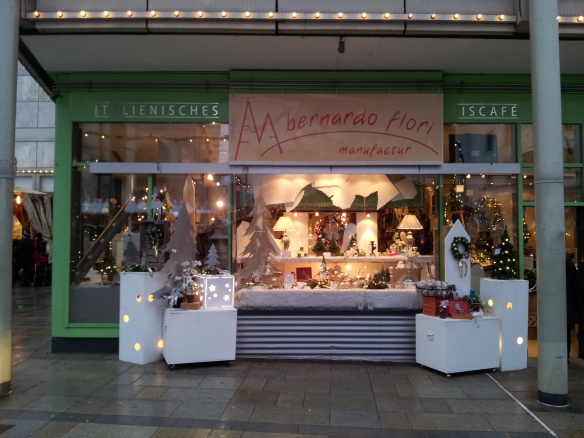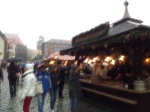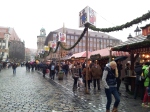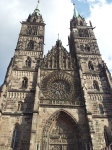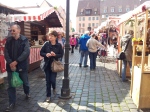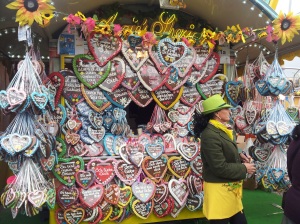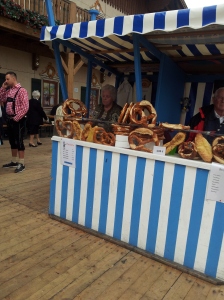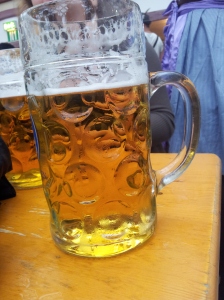One of the most important things to experience when visiting a new country is the cuisine. There are a lot of differences between German and American food, so I thought this would be a good thing to post about. I decided to call it Part 1 because I’m sure I’ll make more observations about German food throughout my stay here.
The first thing I’ll start out with is drinks. One major difference you’ll notice in Germany (and possibly throughout Europe) is how much more prevalent alcohol is, especially beer. One of the strangest things for me is to be able to go into a cafe on campus and see a huge fridge full of beer, and then to walk out into the common area and see students sitting around drinking it at eleven in the morning. Like one of my German friends told me, though, to Germans beer is not really alcohol, so you see it everywhere. And while Germans are usually associated with their beer drinking habits, wine is also a popular option, and one of the two is commonly drunk with a meal.
Pop is another thing I’ve noticed is different in Germany. For one thing, they don’t have Diet Coke. They have a fake Diet Coke, also known as Cola Light. It really doesn’t taste the same, but because they’re supposed to be the same drink, none of the international grocery stores import it, which means I’ll have to do without 😦 Fanta is also much different here, as well as much more popular, but this is definitely a change for the better. It has more of a fruit flavor, and a lot of Americans I know bring back bottles of it for later. Unlike Cola Light and Fanta, however, which have American equivalents, Spezi is a very popular German pop. Typically marketed as MezzoMix, Spezi is a mix of Coca Cola and Fanta. It’s good, but it’s just too sweet for me. However, it’s something new to try when visiting Germany.
Candy is also similar yet different in Germany. For instance, you can buy Snickers, Kit Kats, and Twix here, but I think they taste just a little bit different. I’m partial to the American ones just because they’re what I’m used to. While American candy is popular, Germans have plenty of their own candies to choose from. Haribo is one of the most popular brands you’ll see here in Germany. You’ve probably seen it in the US, because the most popular gummy bears are usually Haribo, but you’ve never seen it like this. They have entire sections dedicated to all of the different gummy candies Haribo produces. I’m really more of a chocolate person, though, so I’m a big fan of Milka. I’m not sure if it’s a German brand or not, but it’s definitely popular here. They’re most famous for their chocolate bars, which I highly recommend, but I also really like the Hazelnut Nussini Bars. And if you’re a fan of chocolate, you should also check out Ritter Sport, which offers chocolate squares in over twenty different flavors. And maybe try Kinder Schokolade while you’re at it, which is chocolate with a milky filling that really enriches the milk chocolate.
Of course, as you would expect, Würste are also really popular in German food. They’re crazy about it. You can get them at a festival in a bread roll with sauerkraut or in a German restaurant with a slice of bread. There are a lot of different types of Wurst and ways to serve it, and they vary by region. I know a very typical Bavarian Wurst is Weißwurst mit süße Senf, or white sausages with a special honey mustard.
While so far I’ve been able to group a lot of my observations by category, some things are just too random for that. For instance, in the US apple strudel is considered a dessert, and here it often is, too. However, one of the vegetarian options you can get at the Mensa is Apfelstrudel. To me that’s just not a meal, so while it’s good, it’s impossible for me to eat for lunch. Also, Germans are crazy about Nutella, which was an easy bandwagon for me to jump on because Nutella is awesome with just about everything. Then there’s the tea. I typically thing of England when it comes to tea, but it’s incredibly popular in Germany as well. Coffee is too, of course, interestingly also using Italian names (which makes it really easy for me to order), but tea definitely takes up more space at the grocery store. I tried some out of curiosity and have to admit to getting hooked, so I like trying a bunch of the different types. And I find it really neat that one of the most popular foods in Germany is Turkish Döners. I think I might have mentioned this already, but they’re really good, so it bears repeating. They vary quite a bit from restaurant to restaurant, which means you should try more than one. Such a chore, right? 😉
Of course, this post barely even scratches the surface of what I could say about German food, but these are just some of the things I keep noticing. This will give you a good idea of what food to start with when you visit Germany, and I’ll keep posting about it as I continue my study abroad experience.

